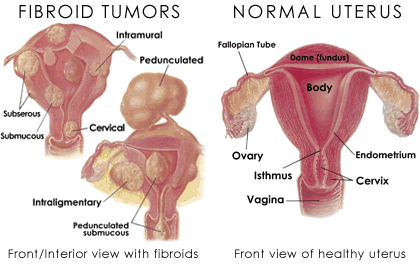
Treatment of Fibroid Tumors
Learn how and when to treat fibroids
WHAT ARE FIBROIDS?
Fibroids are benign solid tumors of the uterus. Other names given to fibroids are myomas, leiomyomas, and fibromas. They represent the most common pelvic tumor found in women. Roughly, 20% of women over the age of 30 and in nearly 40% of women after the age of 40 have fibroid tumors. They can range in size from microscopic to as much as 25 – 50 pounds and may be solitary but are most often multiple. The largest ever recorded weighed 140 pounds!
HOW DO THEY DEVELOP?
Fibroids develop from the muscular layer of the uterus, called the myometrium. Each tumor originates from a single muscle cell, which continuously duplicates itself. They may grow rapidly or very insidiously. They can grow in the presence of the hormone estrogen, as medical studies have found a higher concentration of protein structures called estrogen receptors on their cell surface of the tumors that may make them grow. However not all fibroids enlarge despite receiving high doses of estrogen. Since they are unpredictably responsive to estrogen, they may shrink to varying degrees after menopause.
WHAT SYMPTOMS DO THEY PRODUCE?
Fibroids are usually discovered when they cause symptoms, although many women are asymptomatic when they are diagnosed on routine physical examination. Some women with fibroids experience changes in menstrual patterns. These changes may include heavier bleeding, often with clotting, or periods lasting longer than 7 days, or bleeding between periods. Anemia is a common finding among women with heavy periods related to fibroids, and as a result, they may feel easily fatigued. Pain and pressure in the pelvis are also common complaints among fibroid sufferers, as the enlarging uterus puts pressure on surrounding structures including the bladder (frequent urination similar to early pregnancy) and rectum (constipation and continuous rectal pressure). Pain with intercourse is also common.
HOW ARE THEY DIAGNOSED?
A history of the previously mentioned symptoms will tip us off to the possibility of fibroids. Next, a physical exam may or may not reveal fibroids (some are located deep within the uterus and are therefore difficult to feel). Nevertheless, if symptoms are significant, an ultrasound examination should be done, searching for the etiology. Generally, an office ultrasound will show fibroids clearly. If they are located in the center of the uterus, then office saline hysterosonography will assess whether or not the fibroids may be removed in a conservative fashion.
HOW ARE FIBROIDS TREATED?
If they are small and asymptomatic, they do not need to be treated. They only need therapy if symptoms warrant it. So let’s assume that they are significant in size and symptoms. There are several therapies available:
Oral contraceptives or hormone replacement therapy, in differing dosages and regimens, may control symptoms of irregular bleeding or menorrhagia just fine. If so, they may be continued for a short time, or for a prolonged period. The risks are minimal and should be reviewed in detail with a healthcare professional. The drawback is having to take a pill every day. The benefit may be worth it, however. If they are located in the endometrial cavity (called “submucous”) and are small enough, then Hysteroscopic myomectomy / resection.

Hysteroscopic Myomectomy is a great minimally invasive procedure that can be performed in an outpatient surgery center. This means going into surgery, followed by a short recovery stay prior to being discharged home. Recover takes only a few days at most. Once the submucous fibroid is removed, it should not grow back, and bleeding symptoms should resolve.
If fertility is desired, then myomectomy may be the procedure of choice. This involves removing the fibroid or fibroids via an abdominal incision or by laparoscopy in a minimally invasive way (my preferred method). In this procedure, the uterus is left behind in such a fashion as to be able to carry a pregnancy to term.